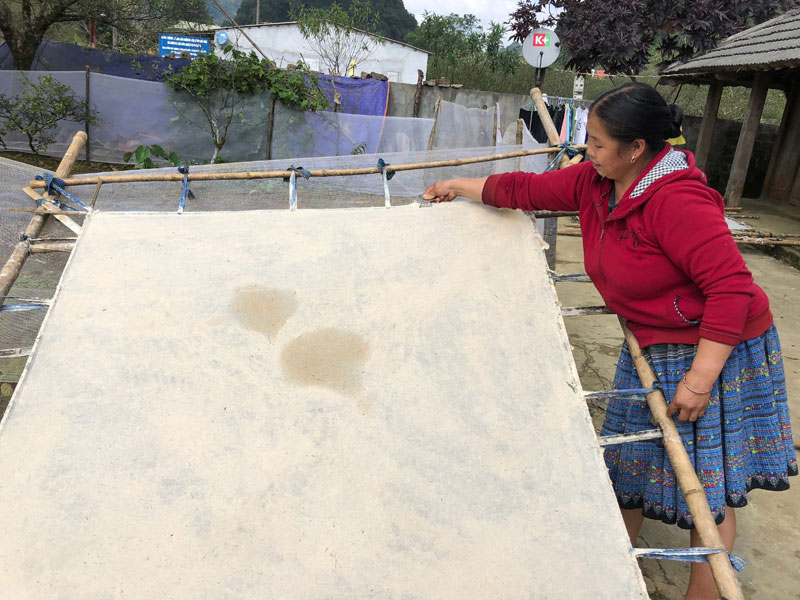
(HBO) - Mong ethnic people in Hang Kia and Pa Co communes (Mai Chau) have also been preserving a lot of cultural beauty through their traditional costumes, languages, handicrafts and so on. In which, linen weaving, beeswax drawing, paper making are being preserved and promoted after a long time of gradual extinction. A large number of tourists coming there also want to learn and experience this unique handicraft art.
 The women of Mong ethnic people in Cha Day hamlet, Pa Co
commune (Mai Chau) are making Do paper (poonah paper).
The women of Mong ethnic people in Cha Day hamlet, Pa Co
commune (Mai Chau) are making Do paper (poonah paper).
Ms. Mua Y Mai in Cha Day hamlet, Pa Co commune says to make
the Do paper from Aganonerion polymorphum, first look for the small young parts
of the plant, peel off the hard shell, then mix them with the ash and put it in
cooking pans. The cooking time is up to 3 days and 2 nights. To be more
successful, they are put into the sacks, soaked in water for about 10 days and
then picked out. The ash is washed off and then it is smashed into a kind of
powder. The pulp is then mixed into clean water, and stirred until the powder
dissolves. After that, the women prepare the paper molds stretched with mesh
fabric. They use a large ladle to scoop up the liquid pulp to spread onto the
cloth. The finished paper after drying under the sun and wind will be peeled and
folded for use when having important family matters.
Besides, the linen weaving and beeswax painting of the women
of Mong ethnic people are like an art. Ms. Sung Y Mua in Hang Kia hamlet, Hang
Kia commune says that it is necessary to make the wax hot so that it can melt
before drawing the patterns. It is important to keep the fire evenly when
cooking so that the wax does not dry out. Therefore, the drawing person always
sits next to the oven, putting a pen into a hot pan of wax and putting the hand
in straight lines on the fabric. The process of drawing beeswax on fabric seems
simple but takes a lot of effort and time. First of all, it is necessary to
make linen and weave the cloth.
It takes from 6 – 7 meters of linen to make a dress of Mong
ethnic people. And it takes 32 stages to make a linen sheet.
For Mong ethnic people in Hang Kia and Pa Co communes, Do
paper is always associated with the spiritual life. According to Mr. Sung A
Mang, the Chairman of the People's Committee of Pa Co commune, Do paper is
often used in festivals, Tet holidays and for worship.
The amazing natural landscapes, the traditional cultural
identities, the villages of Mong ethnic people in Hang Kia and Pa Co have
created tourist attractions to domestic and foreign tourists coming to Mai Chau
in recent years.
With an increasingly vibrant and widespread emulation movement aimed at building cultured residential areas and cultured families, Yen Thuy District has been making steady progress toward improving both the material and spiritual well-being of its people, while fostering a civilized, prosperous, beautiful, and progressive community.
Once lacking recreational spaces and community facilities, Residential Group 2 in Quynh Lam Ward (Hoa Binh City) has recently received attention for the construction of a new, spacious, and fully equipped cultural house. The project followed the model of state support combined with public contributions in both labor and funding.
The "All people unite to build cultural life" movement, which has been effectively integrated with Kim Boi district’s socio-economic development goals, is fostering a lively spirit of emulation across local residential areas, hamlets, villages, public agencies, and enterprises. In addition, through the initiative, traditional cultural values are being preserved and promoted, while community solidarity and mutual support in poverty reduction and economic development are being strengthened.
A working delegation of the Hoa Binh provincial People’s Committee led by its Permanent Vice Chairman Nguyen Van Toan on June 11 inspected the progress of a project to build the Mo Muong Cultural Heritage Conservation Space linked to tourism services in Hop Phong commune, Cao Phong district.
Born and growing in the heroic land of Muong Dong, Dinh Thi Kieu Dung, a resident in Bo town of Kim Boi district, in her childhood was nurtured by the sweet lullabies of her grandmother and mother. These melodies deeply imprinted on her soul, becoming an inseparable part of her love for her ethnic group's culture. For over 20 years, this love for her hometown has driven Dung to research, collect, and pass down the cultural values of the Muong people to future generations.
In the final days of May, the Ethnic Art Troupe of Hoa Binh Province organized performances to serve the people in remote, mountainous, and particularly disadvantaged areas within the province. These were not just ordinary artistic shows, but they were the meaningful journeys aimed at spreading cultural values, enhancing the spiritual life of the people and contributing to the preservation of ethnic minority cultural identities.



 The women of Mong ethnic people in Cha Day hamlet, Pa Co
commune (Mai Chau) are making Do paper (poonah paper).
The women of Mong ethnic people in Cha Day hamlet, Pa Co
commune (Mai Chau) are making Do paper (poonah paper).